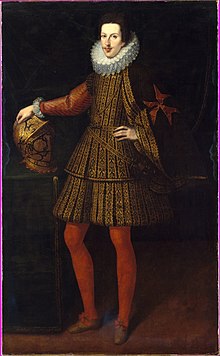Cosimo II
| Cosimo II | |||||
|---|---|---|---|---|---|

Cosimo II after Justus Sustermans
|
|||||
| Grand Duke of Tuscany | |||||
| Reign | 17 February 1609 – 28 February 1621 | ||||
| Predecessor | Ferdinando I | ||||
| Successor | Ferdinando II | ||||
| Born | 12 May 1590 Palazzo Pitti, Florence, Tuscany |
||||
| Died | February 28, 1621 (aged 30) Palazzo Pitti, Florence, Tuscany |
||||
| Consort | Maria Maddalena of Austria | ||||
| Issue Detail |
Ferdinando II, Grand Duke of Tuscany Cardinal Gian Carlo Margherita, Duchess of Parma Mattias, Governor of Siena Francesco Anna, Archduchess of Austria Cardinal Leopoldo |
||||
|
|||||
| House | House of Medici | ||||
| Father | Ferdinando I | ||||
| Mother | Christina of Lorraine | ||||
| Religion | Roman Catholicism | ||||
| Full name | |
|---|---|
| Cosimo de' Medici |
|
Styles of Cosimo II de' Medici, Grand Duke of Tuscany |
|
|---|---|
 |
|
| Reference style | His Highness |
| Spoken style | Your Highness |
| Alternative style | Sir |
Cosimo II de' Medici (12 May 1590 – 28 February 1621) was Grand Duke of Tuscany from 1609 until 1621. He was the elder son of the then incumbent Grand Duke and Christina of Lorraine. He married Maria Magdalena of Austria, and had eight children.
For the majority of his eleven-year reign, he delegated the administration of Tuscany to his ministers. He is best remembered as the patron of Galileo Galilei, his childhood tutor. He died of tuberculosis in 1621.
Cosimo de' Medici was the elder son of Ferdinando I de' Medici, Grand Duke of Tuscany, and Christina of Lorraine. His father requisitioned a modern education for him: Galileo Galilei was Cosimo's tutor between 1605 and 1608. Ferdinando arranged for him to marry Archduchess Maria Maddalena of Austria, daughter of Archduke Charles II, in 1608. Together they had eight children, among whom was Cosimo's eventual successor, an Archduchess of Inner Austria, a Duchess of Parma and two cardinals.
Ferdinando I died in 1609. Due to his precarious health, Cosimo did not actively participate in governing his realm. Just over a year after Cosimo's accession, Galileo dedicated his Sidereus Nuncius, an account of his telescopic discoveries, to the Grand Duke. Additionally, Galileo christened the moons of Jupiter the "Medicean stars". Galileo's advocacy of Copernicanism later led to his trial by the Roman Inquisition, and he was held under house arrest in Tuscany from 1633 until his death in 1642.
The Grand Duke assiduously enlarged the navy. He died on 28 February 1621 from tuberculosis. He was succeeded by his elder son, Ferdinando. The child-Grand Duke's regency was bestowed upon Cosimo II's wife and mother, as per his wishes.
...
Wikipedia
